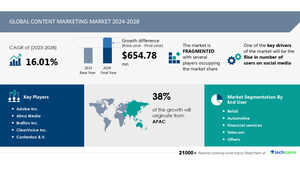NEW YORK, Aug. 21, 2024 /PRNewswire/ -- The global submarine power cable market size is estimated to grow by USD 5.11 billion from 2024-2028, according to Technavio. The market is estimated to grow at a CAGR of over 13.64% during the forecast period. Growing offshore renewable energy installations is driving market growth, with a trend towards increase in sales of hvdc power cables. However, capital-intensive installation and maintenance of submarine power cables poses a challenge. Key market players include ABB Ltd., Eland Cables Ltd., Europacable, Fujikura Co. Ltd., Furukawa Electric Co. Ltd., HELUKABEL Romania Srl, Hengtong Group Co. Ltd., Hydro Group, Jiangsu Zhongtian Technology Co Ltd, KEI Industries Ltd., Leoni AG, LS Cable and System Ltd., Nexans SA, NKT AS, Parker Hannifin Corp., Prysmian Spa, Southwire Co. LLC, Subsea 7 SA, Sumitomo Electric Industries Ltd., and The Okonite Co..
Get a detailed analysis on regions, market segments, customer landscape, and companies - Click for the snapshot of this report
Forecast period |
2024-2028 |
Base Year |
2023 |
Historic Data |
2018 - 2022 |
Segment Covered |
Type (Single core and Multicore), Application (Offshore wind, Island connection and inter-country, Offshore oil, and Others), and Geography (Europe, APAC, North America, Middle East and Africa, and South America) |
Region Covered |
Europe, APAC, North America, Middle East and Africa, and South America |
Key companies profiled |
ABB Ltd., Eland Cables Ltd., Europacable, Fujikura Co. Ltd., Furukawa Electric Co. Ltd., HELUKABEL Romania Srl, Hengtong Group Co. Ltd., Hydro Group, Jiangsu Zhongtian Technology Co Ltd, KEI Industries Ltd., Leoni AG, LS Cable and System Ltd., Nexans SA, NKT AS, Parker Hannifin Corp., Prysmian Spa, Southwire Co. LLC, Subsea 7 SA, Sumitomo Electric Industries Ltd., and The Okonite Co. |
Key Market Trends Fueling Growth
Submarine High Voltage Direct Current (HVDC) power cables are gaining popularity for long-distance, bulk power transmission, particularly in Europe. HVDC systems are economically viable for cross-border energy projects, aimed at ending energy isolation and fostering the growth of the European internal energy market. Renewable energy sources, driven by the Kyoto Protocol and EU's target of sourcing 20% energy from alternative sources by 2020, are on the rise. Many renewable projects, such as offshore wind farms and solar energy plants, are located far from energy load centers, leading to high power transmission losses using Alternating Current (AC) lines. HVDC cables, with their lower weight and ability to transmit power over long distances with minimal losses, are an ideal solution for these projects. The increasing number of offshore wind energy projects in Europe will significantly boost the demand for submarine HVDC cables, driving market growth during the forecast period.
The Submarine Power Cable market is thriving due to the increasing trend towards renewable energy, particularly offshore wind energy. With the expansion of offshore wind farms and floating wind technology, there is a growing demand for underwater cables to transmit electricity from deep-sea wind turbines. Cable manufacturing companies are investing in innovative green solutions, such as Cross-linked polyethylene (XLPE) conductors and high-voltage cables, to meet the needs of this sector. International borders present challenges for cable systems, requiring contractual agreements and regulations. Notable players like Reka kapeli oy are leading the way in green innovation through alliances and acquisitions. The market is also driven by renewable energy targets and the push towards carbon neutrality. Urbanization and global data traffic increase the need for electricity transmission, leading to an increase in demand for underwater cables. Safety zones and underwater power lines are essential for international grid connectivity and renewable energy production. The market includes both high-voltage and medium-voltage power cables, with dry plant components and wet plant components. Production costs remain a key consideration, as does the use of conductive materials like aluminum and copper. The market includes notable projects such as the Arabian Gulf Link and Playa Blanca, which demonstrate the importance of submarine power cables in renewable infrastructure. The market also includes thermal power, marine wind turbines, and cable systems for both offshore and onshore wind turbines.
Discover 360° analysis of this market. For complete information, schedule your consultation- Book Here!
Market Challenges
- The submarine power cable market faces significant challenges in the installation and maintenance of cables due to their capital-intensive and risky nature. The first challenge is selecting a safe and accessible path for cable installation, which must be sustainable for 25 years. Obtaining necessary permits from authorities is also a major hurdle, as cables pass through various maritime boundaries. Once approved, the path is surveyed, and cables are designed, manufactured, and loaded onto ships. The installation process itself is critical, involving precise placement, seabed protection, and maintaining a fixed path. A single error at any stage can jeopardize the entire project. After installation, cables undergo testing before being handed over to owners. These challenges make the submarine power cable market a complex and demanding industry.
- The Submarine Power Cable market faces several challenges in meeting the increasing demand for electricity transmission due to urbanization and global data traffic, which generates terabytes per second. Safety zones around underwater cables in areas like the Scottish Highlands and the Arabian Gulf pose installation challenges. Renewable infrastructure, such as wind power from marine and offshore wind turbines, requires long-distance underwater power lines. The use of conductive materials like Cross-linked polyethylene (XLPE) in conductor materials is crucial for cable systems. Contractual agreements and production costs are key considerations in international grid connectivity. Market enhancement relies on advancements in conductive materials and PESTEL Analysis of economic variables. Reka kapeli oy and other players face challenges in supplying cable systems for thermal power and underwater power lines, as well as medium-voltage and high-voltage segments. Dry and wet plant components must be durable to withstand the harsh marine environment.
For more insights on driver and challenges - Download a Sample Report
Segment Overview
This submarine power cable market report extensively covers market segmentation by
- Type
- 1.1 Single core
- 1.2 Multicore
- Application
- 2.1 Offshore wind
- 2.2 Island connection and inter-country
- 2.3 Offshore oil
- 2.4 Others
- Geography
- 3.1 Europe
- 3.2 APAC
- 3.3 North America
- 3.4 Middle East and Africa
- 3.5 South America
1.1 Single core- In 2023, single core submarine power cables emerged as the leading type in the global market, generating significant revenue. These cables, featuring one conductor enclosed in a protective sheath, offer numerous benefits for long-distance underwater power transmission. Their flexible design and compact construction make them ideal for offshore renewable energy projects and international power connections. Single-core cables boast greater insulating qualities and fewer transmission losses, ensuring efficient and consistent power supply. Their ability to withstand harsh environmental conditions, including high pressure and corrosive seawater, adds to their appeal. Additionally, their streamlined installation process and minimal maintenance requirements contribute to their growing popularity. As a result, single core submarine power cables are poised to dominate the market for reliable and effective submarine power transmission worldwide. Consequently, the demand for these cables is projected to surge, leading to substantial market growth during the forecast period.
For more information on market segmentation with geographical analysis including forecast (2024-2028) and historic data (2018 - 2022) - Download a Sample Report
Research Analysis
The Submarine Power Cable Market is witnessing significant growth due to the increasing adoption of offshore wind energy as a part of the renewable energy mix. Offshore wind farms, which utilize floating wind technology and deep-sea wind turbines, require extensive underwater cable systems for electricity transmission. Cable manufacturing is a crucial aspect of this market, with the demand for conductive materials and advanced cable systems on the rise. International borders pose challenges in terms of regulations and safety zones, but advancements in technology are enabling longer cable lengths and higher capacity underwater power lines. Urbanization and global data traffic are also driving the need for reliable and efficient electricity transmission infrastructure, including submarine power cables. The market is expected to continue growing, with thermal power and marine wind turbines also contributing to the demand for underwater power lines.
Market Research Overview
Submarine power cables play a crucial role in transmitting electricity from offshore renewable energy sources, such as offshore wind farms and marine wind turbines, to the main power grid. With the increasing focus on renewable energy and carbon neutrality, the demand for submarine power cables is expected to grow significantly. Offshore wind energy, including offshore wind farms and floating wind technology, is a key contributor to this market. Cable manufacturing for submarine power cables involves the use of conductive materials like Cross-linked polyethylene (XLPE) and various conductor materials. International borders and regulations pose challenges to the market, requiring contractual agreements and adherence to safety zones around underwater cables. The market is also influenced by intermittent renewable sources, urbanization, and global data traffic, which necessitates high-capacity underwater power lines capable of transmitting terabytes per second. Notable trends include alliances, acquisitions, and green innovation in cable systems. The Arabian Gulf and Playa Blanca are among the regions seeing significant investment in submarine power cable infrastructure. Economic variables, including production costs and international grid connectivity, also impact the market. A PESTEL Analysis reveals additional factors, such as political, environmental, social, technological, economic, and legal influences.
Table of Contents:
1 Executive Summary
2 Market Landscape
3 Market Sizing
4 Historic Market Size
5 Five Forces Analysis
6 Market Segmentation
- Type
- Single Core
- Multicore
- Application
- Offshore Wind
- Island Connection And Inter-country
- Offshore Oil
- Others
- Geography
- Europe
- APAC
- North America
- Middle East And Africa
- South America
7 Customer Landscape
8 Geographic Landscape
9 Drivers, Challenges, and Trends
10 Company Landscape
11 Company Analysis
12 Appendix
About Technavio
Technavio is a leading global technology research and advisory company. Their research and analysis focuses on emerging market trends and provides actionable insights to help businesses identify market opportunities and develop effective strategies to optimize their market positions.
With over 500 specialized analysts, Technavio's report library consists of more than 17,000 reports and counting, covering 800 technologies, spanning across 50 countries. Their client base consists of enterprises of all sizes, including more than 100 Fortune 500 companies. This growing client base relies on Technavio's comprehensive coverage, extensive research, and actionable market insights to identify opportunities in existing and potential markets and assess their competitive positions within changing market scenarios.
Contacts
Technavio Research
Jesse Maida
Media & Marketing Executive
US: +1 844 364 1100
UK: +44 203 893 3200
Email: [email protected]
Website: www.technavio.com/
SOURCE Infiniti Research, Inc.

WANT YOUR COMPANY'S NEWS FEATURED ON PRNEWSWIRE.COM?
Newsrooms &
Influencers
Digital Media
Outlets
Journalists
Opted In






Share this article